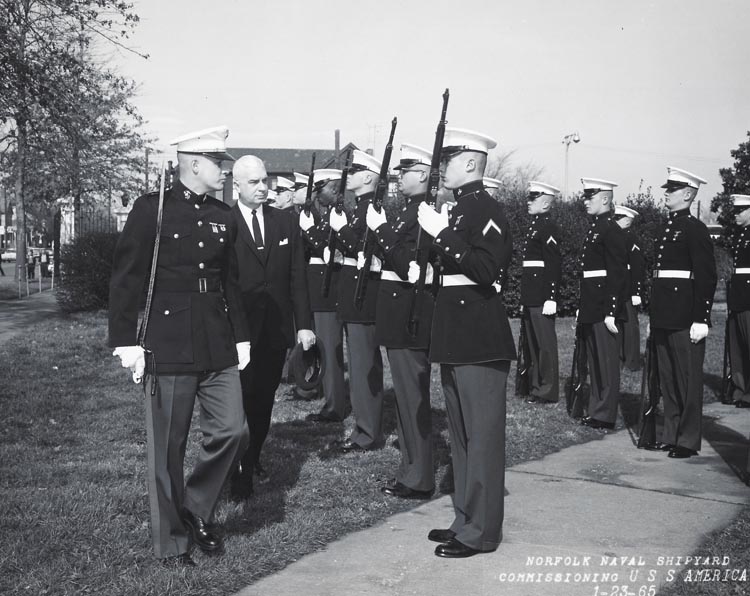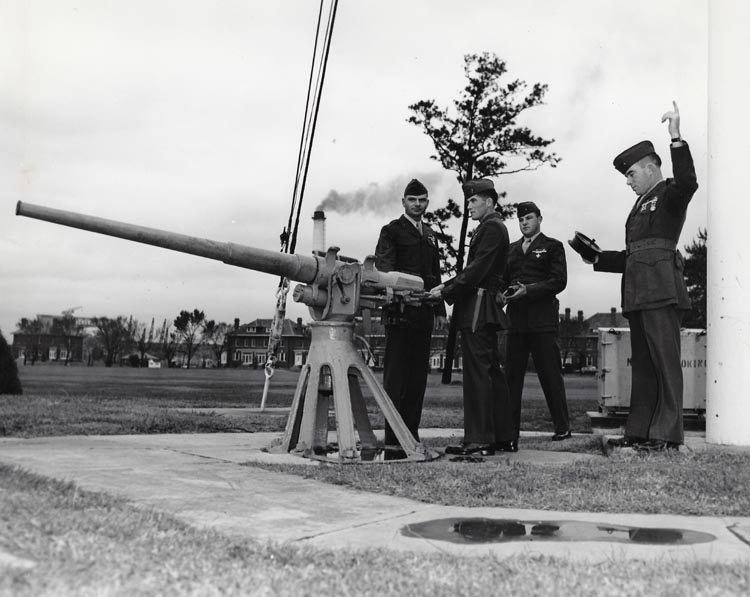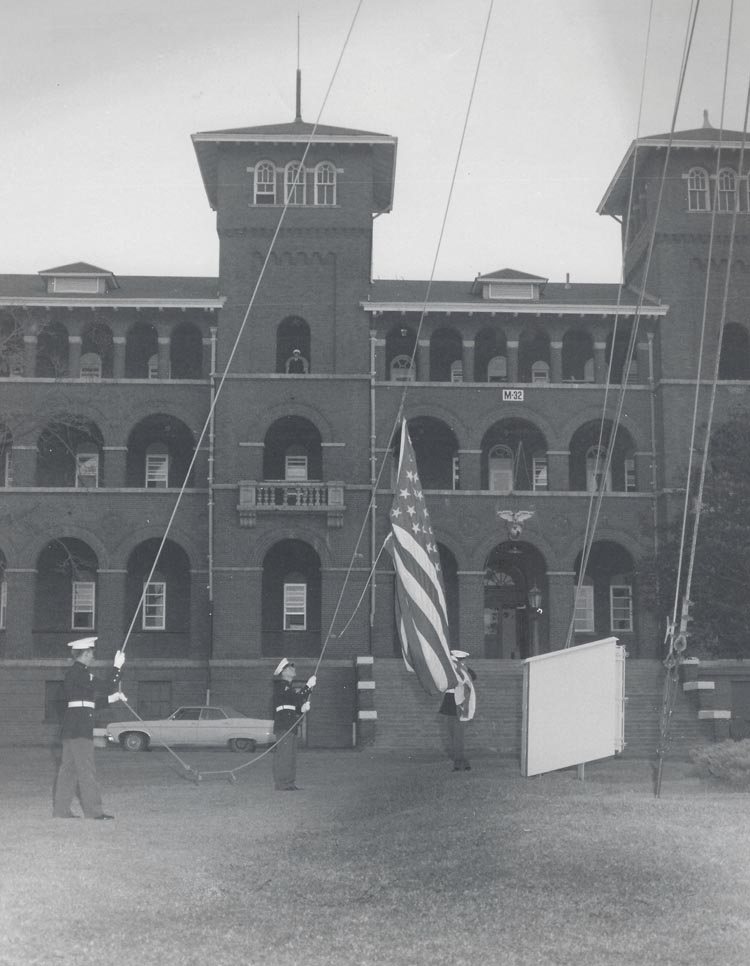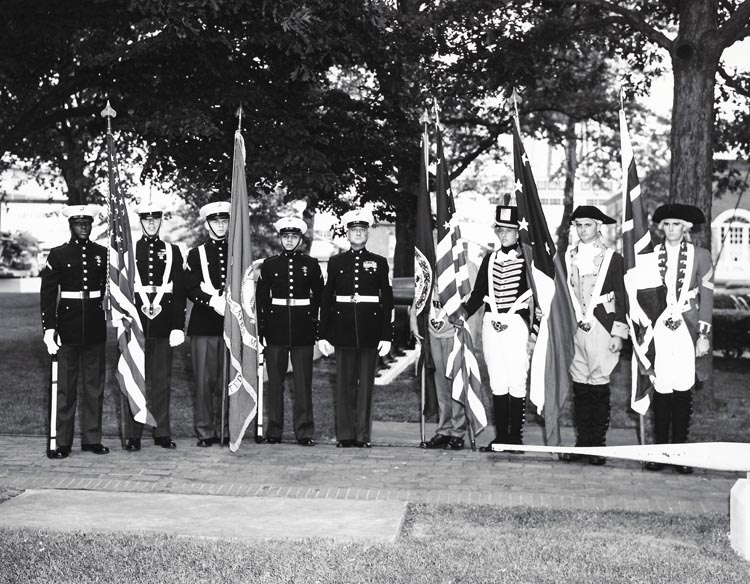U.
S. Marine Corps - Part of Our Armed Forces: Guardians of Our Freedom
Service
to the Fleet,
May 17, 1974
The Shipyard Marine Barracks' personnel, part of an elite corps of our Armed Forces, could be described as an active force involved in such essential tasks as security, training, supply, merchandising, maintenance and other areas of importance to any organization. Their responsibilities do not end there, since some marine facilities serve the general military and civilian population.
These include Marine patients undergoing treatment at the Portsmouth Naval Hospital, students attending the U. S. Navy School of Cryogenics within the shipyard itself, and students of the Sea School Atlantic.
It is a quiet, most businesslike atmosphere that impresses the visitor to the Marine Barracks which lends importance to the mission performed there. The mission of the Barracks is to "provide such security as approved by the Chief of Naval Operationss in coordination with the Commandant of the Marine Corps and perform such additional functions as directed by the Commandant." The Marines provide perimeter security guards, sentries for the gates, of the shipyard. Their responsibilities also include "additional security as directed for other short term military and emergency operations.
Marine Color Guard Serves All: The immaculate, well dressed group of men who form the color guard for many a ceremony here, and in the community, are representatives from the Shipyard Marine Barracks. They are the men who conduct ceremonies as colors are posted and retired, (rendering honors to the flag), daily at 0800 and at sunset.
Mehargue Is Barracks CO: Marine Barracks personnel here number approximately 150, and at the helm is Col. David G. Mehargue, commanding officer. Next in the chain of command is Lt. Col. Charles M. Welzant, executive officer, and Capt. David F. Jones, adjutant. Others who serve in the organisational structure are Capt. Richard H. Clampitt, maintenance officer, Capt. Rodney L. Bowers, supply officer, Lt. Mark W. Gardner, ships detachment supply officer and Marine Corps Exchange officer, Lt. William R. Spain, guard officer, and Sgt. Maj. Fetu L. Falo, barracks sergeant major, the top enlisted man. All Marines, as well as those stationed here, are a major part of our fighting forces. They are part of the "select" group that recruits with the slogan, "we need a few good men."
Physical Fitness Is Vital: Marine Corps (MC) physical fitnes is a way of life with the men of the Barracks. The high fitness and personal appearance standards are met only through rigid physical fitness training. A more relaxed form of fitness is through weekly organized athletics in which all Marines participate.
Sea School Atlantic Train Marines: Additionally, the Barracks here has jurisdiction of the Sea School Atlantic, the only school of its kind on the East Coast. The school has a staff of 11, and approximately 35 students pass through its doors each month in preparation for duty aboard ships. Interestingly enough, although some of their duties differ, others are similar in nature to those of other Marines, but are performed on different types of ships, such as aircraft carriers, heavy cruisers, command ships and nuclear submarine tenders.
Capt. M. D. Buchanan, Jr., officer in charge of the Sea School, outlined the dutues of a Marine aboard ship as:Limiting access to areas of the ship where sensitive information or nuclear weapons are stored to only those authorized to be there.
Running the ship's brig.
Acting as a nucleus to train the ship's landing party, composed of both Marines and sailors.
Providing the "pomp and circumstance" surrounding ceremonial occasions, such as dignitaries visiting aboard ship.
Serving as orderlies and drivers for sea-based flag officers and ships' captains.These young Marines receive instruction in naval history, communications, terminology, rates and ranks, ships' rocognition, organization, compartmentation, nomenclature, use of weapons, firefighting and damage control, and emergency drills.
Nine O'Clock Gun Involves Yard, Community: Speaking of weapons and guns in particular, Marines specialize in this area. There is one gun that has been the subject of many a conversation. It's the nine o'clock gun which is shrouded in history and tradition. The custom had its beginnings with the early British and American Navies on whose ships an evening gun was fired to signal "tattoo." The Pennsylvania, a receiving ship in the Gosport Navy Yard, now the Norfolk Naval Shipyard, observed the custom by firing at 8 p.m. in winter and 9 p.m. in summer.
Editor Suggests Setting Time: A suggestion from a local newspaper editor, dated Nov. 12, 1847, asked that consideration be given to firing the gun with chronometer precision each evening at the same time, either 8 or 9 p.m. Capt. Lawrence Kearney, then shipyard commandant, accepted the idea and ordered the gun be fired at 9 p.m. During these early years, when the chronometer aboard ships was the most accurate timepiece around, the gun served the purpose of being a way to regulate community timepieces. Through the years, even to this day, people use the firing of the gun as a time to check clocks and watches. Many youngsters have been required to be home by nine, or when the gun fires.
Marines have continued to fire the traditional "nine o'clock gun" since Sept. 5, 1866. "It may be that the firing of the cannon originally signaled a curfew clamped on the city during the era of reconstruction. Posibly the gun first boomed to warn tavern keepers to aim erring sailors and marines toward the nearest exit, thus giving them a fighting chance to reach the yard before lights went out." Whatever the custom, purpose, or origin, the firing of the gun was officially stopped just once during the long history of the yard, and then for only a short period.
Gun Fires Each night: So it is, the practice continues, and at 9 p.m. each evening the Marine Barracks Sergeant of the Guard fires the guns from the Shipyard's Signal Battery, located in front of the Marine Barracks on the parade field.
Weaponry isn't the only area where marines specialize, because they seem to be good businessmen. The Marine Barracks Post Exchange and Enlisted Men's Club do a gross bussiness of approximately $1 million a year. Lt. Mark S. Gardner, who is in charge of the exchange, is also Supply Officer Ships Detachments, which covers marines on approximately 16 Atlantic Fleet ships. The Marine Corps Exchange, 2-35, is located in the barracks compound just inside Gate 15. It serves as a specialty store and is open to marines on dury at the barracks, Sea School students, military personnel in the yard, dependents, and to the general military population as well as retirees.
The store has three merchandise departments with necessary articles ranging from cigarettes, stationery and magazines, to jewelry, watches, cameras, gift items and a complete stereo and electronics shop. There is a selection of high fashion clothing that would meet with the approval of the most discriminating man or woman. There is also a country store where such items as toys, sporting good, household and garden supplies, and a limited assortment of packaged foods, beer and dairy products may be purchased. The Country Store is open seven days a week. Special orders for items which are not available will be taken in the Exchange Office.
Under the umbrella of the exchange is the operation of a laundry and dry cleaning service, a tailor shop and a barber shop. The club for enlisted men, Little Tun Tavern, offers good food, mixed drinks, and beer. In addition to other foods, breakfast is served all day from 11 a.m. to 4 p.m., and during these hours the club is open to civilian as well as military personnnel. At this time the club is the only facility for enlisted men in the yard, and appropriate attire is civilian clothes or the uniform of the day. Utility or dungaree uniforms may be worn until 6 p.m.* * * * * * * * * *
DEACTIVATION
of the THE MARINE BARRACKS
News from the Norfolk Naval Shipyard Public Affairs Office
27 September 1978
Deactivation Ceremonies for Marine Barracks, Portsmouth, VA
THE FLAG IS LOWERED DURING THE CEREMONIAL CLOSING OF THE 176-YEAR -OLD BARRACKS
MARINES IN THE DRESS OF PERIODS FROM 1802 TO THE PRESENT REVIEW THE HISTORY OF THE MARINE BARRACKS
CAPTAIN ALFRED KURZENHAUSER SPEAKS AT THE DEACTIVATION CEREMONIES
Marine Barracks, Portsmouth, has a long and distinguished history. After Marine Barracks, Washington, it is the oldest barracks in continuous service in the Marine Corps. The first official record of Marines at this station was April 1802, when 1st LT. Josiah Reddick and some 20 enlisted Marines arrived at the then Gosport Shipyard. Since that time, the Marines have provided security for the shipyard, in addition to many other mission assignments.
* * * * * * * * * *
Service to the Fleet September 1978
An era in Norfolk Naval Shipyard and Marine Corps history ended when the Marine Barracks here conducted its finally ceremony at 7 p.m. Wednesday, Sept. 20, on the Marine Barracks Parade Field.
The ceremony, the last before the Sept. 30 disestablishment of the command, featured a review of the history of the Barracks, the second oldest post in the Corps, and a parade. Music for the occasion was rendered by the Marine Corps Development and Education Command Band from Quantico, VA.
A precision drill team from the USS INDEPENDENCE highlighted the evening's activities with an outstanding demonstration. Marines from the Fleet Marine Force Atlantic also participated in the ceremony.
The Barracks, whose last commanding officer was Lieutenant Colonel James B. Hicks, Jr., are steeped in history, and a marine guard was first ordered here in October 1801. An April 1802, 1st Lieutenant Josiah Reddick and some 20 enlisted Marines arrived at what was then known as the Gosport Shipyard. Since that time, Marines have provided security and other assigned duties at the shipyard, except for periods when they were withdrawn for participation in combat operations, specifically, against the Barbary pirates, and the Indian Wars in Florida, plus the Mexican, Civil, and Spanish-American Wars.
The Barracks have been the home of many men who have taken their place in the history of this nation. Several Medal of Honor winners have served here. A number of Commanding Officers have gone on to become Commandant of the Marine Corps. Marines who served here met challenges all over the world and etched our country's name deep in the honor roll of free nations.
Marines who have served at these traditional Barracks have also become a part of the history of the City of Portsmouth through their participation in various activities, ceremonies, and parades.
Organizational colors of the Norfolk Naval Shipyard Marine Barracks are now on permanent display at the Portsmouth Naval Museum at the foot of High Street in Portsmouth.
Service to the Fleet September 26 May 1978
The historic presence of the United States Marine Corps here at the Norfolk Naval Shipyard will soon end. Marines have been stationed in the yard continuously since November of 1807, but the official word is to disestablish Marine Barracks, Portsmouth, effective September 30, 1978.
Major reasons for closing the Barracks are these.
Congress directed a cut in the end strength of the Marine Corps for Fiscal Year-77 and suggested that the reduction be taken in Marines serving as guards for the Navy and National Security Agency shore installations, excluding overseas and nuclear weapons storage sites. The Chief of Naval Operations and the Commandant of the Marine Corps agreed to reduce Marine Corps Security Force personnel through consolidations and closures of certain Marine Barracks where Marines provided low priority guard services.
Through the end of FY-77, consolidations of eight Marine Barracks and closures of ten barracks were approved. Two of the ten closures were among the eight previously consolidated. The Marine Barracks Portsmouth was originally planned to be consolidated with Marine Barracks Norfolk, but this action was not approved because of community and political objections. Consequently, the additional manpower reductions to meet the imposed end strength reductions were taken in Fleet Marine Force units. Closing the Barracks here will permit restoration of these manpower cuts.
The Navy also has a significant requirement for additional bachelor enlisted housing for sailors assigned to fleet ships undergoing overhauls in the shipyard. The vacated Barracks will partially fill this need.
All facilities vacated by the Marines will be used. The Barracks (Bldg, M-32), recent renovation at a cost of $980,000, completed in October 1976, was accomplished specifically for modifying substandard quarters to meet Department of Defense habitability criteria.
The second and third floors will be used to billet enlisted Navy. The first floor, now Marine Barracks office space, will be home for the shipyard Security Division, which will move from Bldg. 72 this year.
The Marine Exchange, which is located in the basement of M-32, will close its operation June 30. However, the Seven-day Store, which sells small personal items, will remain open until September 30. Present plans call for the basement floor to house a Navy Exchange military uniform shop and convenience store, a commercial banking facility, and the Navy Yard Credit Union.
Other plans are for the Navy Exchange to operate the Little Tun Tavern much in the same way as it presently operates, that is, as a recreation center, a fast food restaurant and over the counter beer sales for military personnel. The Little Tun Tavern is an important facet of the Shipyard's efforts to keep sailors from going into dangerous areas.
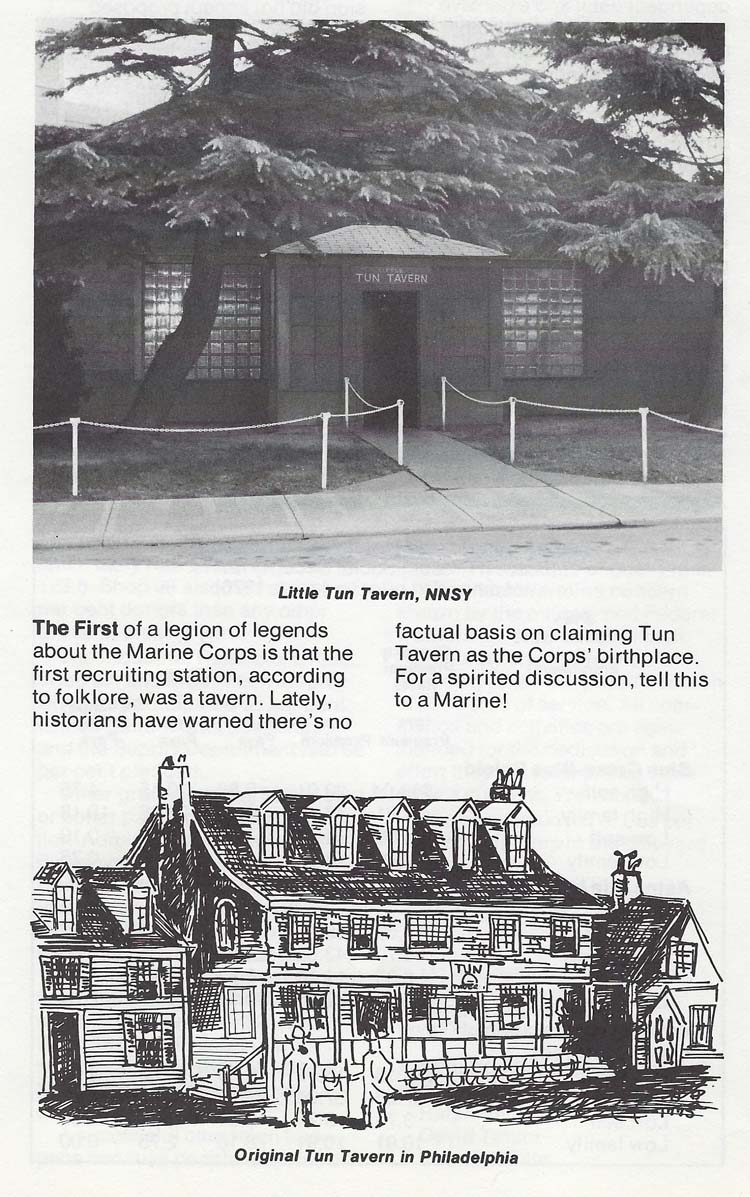
Presently there are 96 permanent enlisted Marines and five officers stationed at the Barracks. It also handles Marine personnel who are either waiting for orders after being hospitalized at the Naval Regional Medical Center Hospital in Portsmouth, or who are waiting for medical board action. When September 30 arrives, they will be transferred to different Marine outfits throughout the country.
This is not the first time that the Marines have left Portsmouth. It's happened five time before during the last 176 years. They've come back before, and, perhaps, someday they will return.
* * * * * * * * * *
